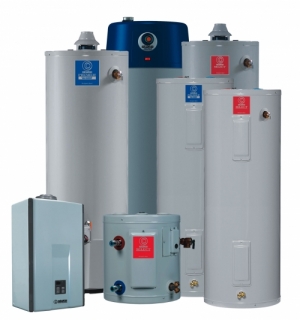
When it’s time for a new water heater most people just tell the installer “replace the old one, with the same kind.” But that’s missing an opportunity to make improvements, often at little added cost. And often you can grab considerable dollar savings in the long run by picking the water heater technology that’s best for you.
What to Consider When Choosing Your Replacement Water Heater
Your first choice is whether or not you actually need a new water heater. Pilot light problems, a leaky valve or fitting, or even a burned-out heating element can usually be economically repaired. But if the tank itself is leaking, corroded, or heavily scaled, a water heater replacement is necessary.
If your heater is old and well past its warranty period then it’s probably time to replace it, especially if it has needed other repairs in the last few years. As a bonus, newer units are typically more energy-efficient, saving on your monthly utility bills, and may even include additional safety factors. Considering the several repair versus replace issues and the wide range of replacement options, it’s a good idea to consult a plumber who is experienced with a variety of makes, models, and technologies.
Here are a few things to consider when choosing a replacement water heater.
Fuel Type
The type of fuel used affects the size, energy efficiency, installation cost, and operating cost of the water heater. Most water heaters are either natural gas or electric in the San Diego area, but propane-fueled heaters are common in the countryside and fuel oil is often used in the northeastern United States.
The original choice of fuel type is probably the right one. But if it’s electric and natural gas is now available it may be time to switch. If only electricity is available it’s worth considering a heat pump domestic hot water heater. A heat pump uses electricity to move heat from one place to another (that is, into your water) rather than directly converting electricity into heat energy (like a regular electric heater). That drastically cuts down electricity bills, but these units have somewhat higher maintenance costs and significantly higher purchase and installation costs.
Nowadays you can also consider solar water heating. Solar-thermal systems have been fairly common for decades, and solar-electric (photovoltaic) systems are now cost effective. If you go solar you should keep a gas-fired heater as backup, and consider a heat-pump if you’re going photovoltaic
Size
If you’ve been happy with your old heater and have been getting enough hot water, you’ll probably want to keep the same size tank and “firing rate.” But keep in mind that larger heaters cost more, and may not be as efficient in actual use. Proper sizing depends on total hot water usage and when it’s used. One rule of thumb suggests 20 gallons of tank capacity per person. But if, for example, you often run the clothes washer while people are showering you’ll need to add another 20 or more gallons. There are many more detailed sizing methods commonly used by the experts, and you can find many of them on the web. But it’s best to rely on a trustworthy plumber.
Efficiency
Once you have a fuel type and size, take a look at various makes and models and do a comparison of operation costs. The Energy Star rating on the unit or store display should show typical annual fuel costs and you can use these to determine which will cost less in the long run.
Tankless Water Heaters
Besides solar, there’s another technology to consider.
Standard storage water heaters use a large tank to hold hot water so that it can be delivered faster than the burner or heating element can provide. The tank loses heat to its surroundings, wasting a little energy as the water gradually cools down. Tankless water heaters work on-demand, heating the water as it flows through the heater. They’re sized by firing rate, that is the gallons-per-minute of hot water they can supply, rather than a tank size. With no standby losses they use significantly less energy, but are also significantly more expensive to purchase and install. They can often be located right where the hot water is used, say in the master bathroom, to provide instant hot water with no waiting.
Final Choice
In your final selection you should go with a major brand, considering the reputation of the manufacturer and consumer experience with a particular model. The length of the warranty is a good indication of quality, with coverage typically ranging from 3 to 12 years. Units with longer warranties, although more expensive, also tend to have faster heating recovery and be better insulated. High-end features such as electronic controls and displays may help save energy, but may also be simply a matter of personal preference.
Conclusion
Although there’s a chance you’ll end up choosing the same type and size of water heater, it’s well worth spending some time considering these various factors. You could greatly reduce the lifetime cost (purchase, installation, maintenance, and energy bills) while getting all the hot water you need and want.
ASAP Drain Guys & Plumbing is your San Diego area expert in water heater repair and replacement, for both residential and commercial units. We’re experienced with all types of water heater technologies and all major brands.

